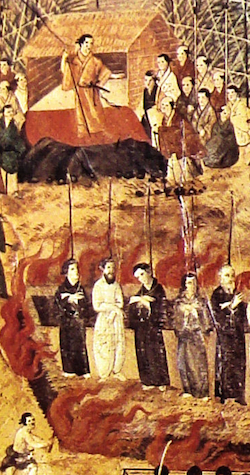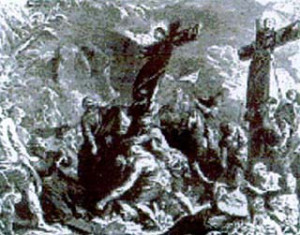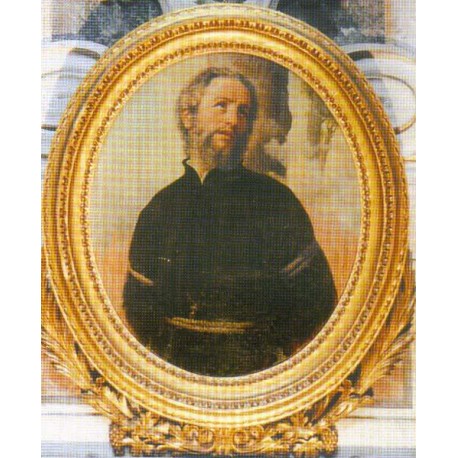Blessed Charles Spinola,SJ; Sebastian Kimura,SJ and Companions
Bl Charles Spinola, SJ
Born: 1564
Died: September 10, 1622
Beatified : May 7, 1867
Bl Sebastian Kimura , SJ
Born: 1565
Died: September 10, 1622
Beatified : May 7, 1867
 Charles Spinola was born in Madrid, Spain. His father the Italian Count of Tassarolo, was tutor to Prince Rudolph, the Emperor’s son. After his early studies in Spain, Charles was sent to the Jesuit school in Nola, Italy where he lived with his uncle Philip Spinola, the Bishop of Nola. As a youth, Charles was so moved by the martyrdom in India of Rudolph Acquaviva’s heroic example of love for God that he too was determined to die for Christ and the faith. He entered the Society and became a novice at the Nola novitiate. In 1584 He went to Naples for his philosophy and after taking his vows, he was sent to Brera College in Milan where he completed his philosophy and even his theology as his health was not too good. After his ordination in 1594, he was assigned to give parish missions in Cremona although he had requested to go on foreign missions.
Charles Spinola was born in Madrid, Spain. His father the Italian Count of Tassarolo, was tutor to Prince Rudolph, the Emperor’s son. After his early studies in Spain, Charles was sent to the Jesuit school in Nola, Italy where he lived with his uncle Philip Spinola, the Bishop of Nola. As a youth, Charles was so moved by the martyrdom in India of Rudolph Acquaviva’s heroic example of love for God that he too was determined to die for Christ and the faith. He entered the Society and became a novice at the Nola novitiate. In 1584 He went to Naples for his philosophy and after taking his vows, he was sent to Brera College in Milan where he completed his philosophy and even his theology as his health was not too good. After his ordination in 1594, he was assigned to give parish missions in Cremona although he had requested to go on foreign missions.
Two years later in 1596 Fr Spinola together with the Sicilian Jesuit, Jerome De Angelis, finally was assigned to the mission in Japan, but it took him six years , eight ships and great patience to arrive in Nagasaki, Japan after overcoming shipwrecks, pirates and many unfortunate incidents along the way. The first ship he took from Genoa struck a rock and was forced to return to Genoa. From Barcelona, he had to walk on foot across Spain and Portugal to reach Lisbon but there the ship met with a violent storm and its rudder was shattered. After five months the ship was repaired in Brazil, they again set forth only to meet another storm and they found themselves drifted back to the Atlantic to its starting point. His second attempt was also unsuccessful and ended when English pirates captured the ship and took it to England and only managed to escape back to Lisbon after two years. It was only in 1600, when Fr Spinola set off on his third attempt and reached Malacca, Malaya.
He finally reached Japan in 1602, and he studied Japanese before going to Miyako (today’s Kyoto) where he was minister at the Jesuit College and also teacher of mathematics and astronomy. He moved to Nagasaki seven years later to care for the temporal needs of the province by which time the long period of peaceful relations with Shogan Iyeyasu ended in 1614 when the number of Christians in Japan reached two million and the country leaders became fearful that it was a national threat and that their country might be taken over by Spain. This resulted in the Shogun’s decree banishing all foreign missionaries and forbade Japanese Christians to harbour priests or practice their religion.
Arising from this decree, about 100 Jesuits left Japan, but some remained, including Fr Spinola and he eluded priest-hunters for four years. Fr Spinola was captured together with Bro Ambrose Fernandes and their catechist, John Chogoku and were imprisoned for four years in a bird-like cage under harsh conditions.
 Sebastian Kimura, the first Japanese to be ordained a priest, was born in Hirado of Christian parents and was the cousin of Br Leonard Kimura. He studied with the Jesuits in Hirado and later at their seminary in Arima before joining them in 1582. He served as a catechist in Miyako before going to Macau for theology and returned to Nagasaki, Japan for his ordination in 1601.
Sebastian Kimura, the first Japanese to be ordained a priest, was born in Hirado of Christian parents and was the cousin of Br Leonard Kimura. He studied with the Jesuits in Hirado and later at their seminary in Arima before joining them in 1582. He served as a catechist in Miyako before going to Macau for theology and returned to Nagasaki, Japan for his ordination in 1601.
Fr Kimura was an eloquent preacher and was very adept at disguising himself when the Jesuits were forced to go undercover during the Great Persecution period. Using different disguises, Fr Kimura was able to visit homes and prisons to administer the Sacraments and his activity soon became the target for his capture by the police. In June 1621 before he could obey his superior’s instruction to leave Nagasaki until the pressure for his capture cooled off, he was arrested together with his catechist, Thomas Kaposi and Louis Kawara, an assistant at the Jesuit residence, betrayed by a Korean servant. They were sent to Suzuta and were imprisoned with Fr Spinola and the other Christians. Kawara and Akahoshi asked to join the novitiate conducted by Fr Spinola in the prison for five others, namely, Anthony Kyuni, Gonzalo Fusai, Peter Sampo, Michael Shumpo and John Chugoku.
 In Sep 1622 the nine prisoners were taken to Nagasaki and felt martyrdom would soon be theirs. Before they left, Fr Spinola accepted the vows of his seven novices. On Sep 9, the nine Jesuits together with twenty-four other prisoners at Suzuta, each with a rope round his neck, and the Jesuits in their cassocks were led to Martyrs’ Hill escorted by 400 soldiers. There they waited for another thirty-three prisoners from the city. When the 2 groups met, they embraced. Fr Spinola recognized Isabel Fernandez among them, the wife of Dominic Jorjes, his host, and her four-year-old son Ignatius. The religious, with exception of John Chugoku were condemned to death by slow fire, the Christians and Chugoku were to be beheaded.
In Sep 1622 the nine prisoners were taken to Nagasaki and felt martyrdom would soon be theirs. Before they left, Fr Spinola accepted the vows of his seven novices. On Sep 9, the nine Jesuits together with twenty-four other prisoners at Suzuta, each with a rope round his neck, and the Jesuits in their cassocks were led to Martyrs’ Hill escorted by 400 soldiers. There they waited for another thirty-three prisoners from the city. When the 2 groups met, they embraced. Fr Spinola recognized Isabel Fernandez among them, the wife of Dominic Jorjes, his host, and her four-year-old son Ignatius. The religious, with exception of John Chugoku were condemned to death by slow fire, the Christians and Chugoku were to be beheaded.
When fastened to his stake, Fr Spinola intoned the psalm, Praise the Lord, All You Nations, and the martyrs joined in a song of thanksgiving to God. The fires were lit but the wood was so arranged to prolong the victims’ suffering. Fr Spinola died within half an hour belonged he was greatly weakened after four years of imprisonment. Fr Kimura, endured his martyrdom for three hours and was the last to die, during which time he remained immobile with his arks outstretched in the form of a cross.
The nine martyrs died on Martyrs’ Hill on Sep 10, 1622 but when Pope Pius IX beatified the 205 Japanese martyrs on May 7, 1867, Bro Ambrose Fernandes, who had died in prison, was also included
